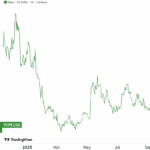- Researchers at Columbia College have discovered as a lot as 25% of the buying and selling quantity on fashionable prediction market, Polymarket, could also be wash buying and selling.
- The researchers don’t counsel Polymarket itself is chargeable for the “synthetic” buying and selling; slightly they imagine customers are doing it partly to maximise any future airdrops.
- The researchers stated they hope Polymarket tries to cut back the extent of wash buying and selling as faux quantity doesn’t add liquidity or data for the market.
As a lot as 25% of the whole buying and selling quantity on the favored blockchain-based prediction market, Polymarket, could also be “fictitious” wash trades, in response to a paper revealed final Thursday by researchers at Columbia College in New York.
Wash buying and selling is a monetary market transaction that doesn’t contain a real change in market place. Widespread examples embody buying and selling between accounts that each have the identical useful proprietor, or repeated shopping for and promoting between colluding accounts inside the bid/ask unfold.
As a part of the research, the researchers created algorithms to determine wash buying and selling on Polymarket by accessing the publicly out there transaction knowledge saved on the Polygon blockchain. The researchers stress that their findings are usually not definitive, however slightly are estimates of the degrees of wash buying and selling. Different prediction markets that don’t run on blockchains, comparable to Kalshi, couldn’t be analysed on this manner since their transaction knowledge will not be public.
One of many research’s co-authors, Yash Kanoria, a professor at Columbia College’s enterprise college, told Bloomberg he’s “hopeful that Polymarket will welcome the evaluation in our paper.”
Wash buying and selling doesn’t add liquidity or data to the market, so it will appear precious to differentiate genuine from inauthentic quantity.
The extent of wash buying and selling the researchers recognized on Polymarket different over time:
- On common over the previous it accounts for about 25% of whole quantity.
- Wash buying and selling peaked at 60% in December of 2024 and dropped to a low of 5% in Might of 2025. By October this 12 months it had risen once more to round 20%.
Round 14% of wallets utilizing Polymarket have been flagged by researchers as doubtlessly participating in wash buying and selling. The researchers don’t counsel of their paper that Polymarket itself is chargeable for the wash buying and selling, however they do say that the platform’s crypto foundations could make it extra susceptible to this sort of misuse.
On unregulated exchanges that use stablecoins or different cryptocurrencies as technique of fee, this downside turns into particularly acute, because the real-world identities of particular person pockets homeowners are usually not noticed, even supposing all transactions between wallets are on-chain.
The authors counsel the current surge in wash buying and selling beginning in early October could also be associated to Polymarket’s deliberate $POLY token, which is predicted to be airdropped to customers in proportion to how a lot they use the platform. By participating in wash buying and selling, customers could also be making an attempt to maximise the dimensions of their airdrop whereas minimising dangers.
One of many researchers, doctoral pupil Allen Sirolly, told Bloomberg that “peaks in natural buying and selling and genuine quantity are linked to information concerning the referenced occasions, however peaks in wash buying and selling usually tend to be linked to rumors about token difficulty.”
Regardless of the underlying trigger, the discovering of such excessive ranges of wash buying and selling on Polymarket is doubtlessly an issue for the platform. It may undermine its declare of having the ability to harness the ‘knowledge of crowds’ and precisely predict the end result of all kinds of occasions, from sports activities to politics to popular culture and just about all the pieces in between.
The paper has but to endure peer evaluate. Polymarket hasn’t commented publicly on the research.
Associated: Google Integrates Polymarket and Kalshi Data Into Search and Finance Tools
Polymarket’s Authorized Troubles
Polymarket has been on the forefront of the emergence of so-called ‘prediction markets’, which permit customers to guess on the outcomes of a variety of occasions.
The platform hasn’t been with out its fair proportion of hassle, although. In 2022, it was formally banned from working within the US, after agreeing to a US$1.2 million (AU$1.8 million) settlement with the Commodity Futures Buying and selling Fee (CFTC) for working an unregistered change.
Associated: Polymarket Wins CFTC Greenlight to Launch US Platform
In July of this 12 months although, Polymarket’s authorized fortunes improved as each the CFTC and the US Division of Justice closed investigations into whether or not it had continued to permit US clients to make use of its platform in breach of the settlement.
Polymarket is now seeking to return to the US market in a totally regulated trend following its acquisition earlier this 12 months of the CFTC-regulated change, QCX.
Australian regulator ACMA additionally instructed ISPs to block access to Polymarket in Australia in August 2025 because of the platform breaching Australia’s Interactive Playing Act (2001).
The put up Study Finds One-Quarter of Polymarket Trading May Be Artificial appeared first on Crypto News Australia.







